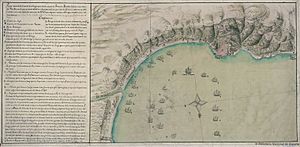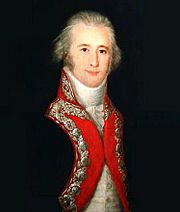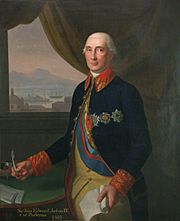Invasion of Algiers (1775) facts for kids
Quick facts for kids Invasion of Algiers |
|||||||
|---|---|---|---|---|---|---|---|
| Part of the Spanish-Algerian war (1775–1785) | |||||||
 Map of the Spanish attack on Algiers in 1775 |
|||||||
|
|||||||
| Belligerents | |||||||
| Commanders and leaders | |||||||
| Strength | |||||||
| Dey's personal guard: ~4,000 cavalry Beylik of Constantine: ~15,000 camelry Beylik of Oran: ~4,000 infantry Beylik of Titteri: ~10,000 Kabyle troops |
20,000-26,000 7 ships of the line 12 frigates 27 gunboats 5 hulks 9 feluccas 4 mortar boats 7 galleys 3 smaller warships 230 transports |
||||||
| Casualties and losses | |||||||
| 300 killed and wounded | 500-800 killed 2,000 wounded 2,000 captured |
||||||
The invasion of Algiers was a huge and unsuccessful attempt in July 1775. Soldiers from Spain and Tuscany tried to capture the city of Algiers. Algiers was the capital of Algeria at that time.
Spanish General Alexander O'Reilly and Tuscan Admiral Sir John Acton led the attack. They had about 20,000 soldiers and sailors. They also had 74 warships and 230 transport ships. Baba Mohammed ben-Osman led the Algerian defenders.
King Charles III of Spain ordered this attack. He wanted to show the Barbary States how strong Spain's army had become. Spain had lost badly in the Seven Years' War. The King also wanted to protect Spain's lands in North Africa. He aimed to reduce the power of the Barbary states in the Mediterranean Sea.
The Spanish ships left Cartagena in 1775 and sailed to Algiers. Near the city, O'Reilly ordered his troops to land on the shore. The warships were supposed to protect the landing boats. But the landing went wrong from the start. The soldiers landed in the wrong spot, which was too sandy. Many heavy cannons got stuck in the wet sand. This meant they could not be used in the fight.
Even without the cannons, the Spanish attacked the Algerian forces. The Algerians seemed to pull back further inland. The Spanish chased them, but it was a trap. The Spanish suffered huge losses, losing a quarter of their force. The Algerians had very few casualties. The Spanish had to retreat back to their boats. This attack was a big failure and a humiliating defeat for Spain.
Contents
Why the Invasion Happened
Spain's army had recently been greatly improved by King Charles III. This happened after Spain's embarrassing defeat in the Seven Years' War. In 1762, Charles had joined the war to support his allies, France.
However, the British quickly captured Havana in America and Manila in Asia. A Spanish attack on Portugal also failed. These defeats made King Charles realize that Spain's military needed big changes. At that time, Spain had some small territories on the coast of North Africa. These lands were always in danger from Moroccan or Ottoman attacks. Charles did not want to lose any more land after giving Florida to the British.
After the Siege of Melilla
In 1774, Spanish forces successfully ended the Moroccan siege on the Spanish city of Melilla. After this, King Charles III decided to send a naval expedition to North Africa. He wanted to show Sultan Mohammed III that Spain would protect its lands.
The main goal was to capture Algiers. It was an important port and a key city for Ottoman Algeria. Alexander O'Reilly, an Irish officer, led the expedition. He had served Spain for a long time. In 1765, he had protected King Charles III from an attack. After the Seven Years' War, he received Havana back from the British. He also stopped a rebellion by French settlers in Louisiana.
Spanish Admiral Pedro Gonzalez de Castejon commanded the naval part of the expedition. Together, they planned the invasion force.
The Battle of Algiers

By June, the invasion force was very large. It included seven large warships, twelve frigates, and many smaller boats. There were 230 transport ships. About 20,000 soldiers, sailors, and marines were ready. They sailed from Cartagena to Algiers.
On the way, they met a small fleet from the Grand Duchy of Tuscany. This fleet was led by Tuscan Admiral Sir John Acton. On July 5, the combined Spanish and Tuscan forces reached Algiers. O'Reilly decided to land the troops to capture the city.
The Spanish troops landed in two groups. The summer heat was very strong and made them uncomfortable. Spanish Admiral Antonio Barceló ordered his warships to protect the landing boats. He kept his ships close to the coast, even though the water was shallow.
Landing Problems and Algerian Trap
O'Reilly gave strict orders to his troops. However, the pilots of the landing boats made a mistake. They chose the wrong landing area. The heavy artillery guns got stuck in the sand dunes on the beach. This made them useless for the battle.
When the Spanish landed, they met light resistance from the Algerians. This was because the Algerian forces were pretending to retreat. The Algerian army had grown much larger. Many warrior tribesmen from inland had joined them. They had been warned by Berber merchants in Marseilles about Spain's plans.
The Spanish moved forward, chasing the seemingly retreating Algerians. But the Algerians led them into a special place. Here, they could hide and attack the Spanish. By the time the Spanish realized they were surrounded, it was too late.
The Spanish forces were defeated and ran back to their ships in a panic. They suffered huge losses, with over 5,000 casualties. Five generals were killed, and fifteen were wounded, including Bernado de Galvez. The Spanish left behind 15 cannons and about 9,000 other weapons.
A British writer, Henry Swinburne, wrote that the Spanish would have been completely destroyed. But Admiral Acton, the Tuscan commander, saved them. He cut his ships' ropes and let them drift towards the shore. His ships fired continuously with grape-shot, stopping the Algerians.
About 2,000 Spanish soldiers were captured. They were cut off from the boats that would take them back to their ships. O'Reilly had to wait a month to negotiate their return. He wanted to bomb Algiers from the sea, but he did not have enough supplies. O'Reilly and the Spanish fleet returned to Alicante. His reputation was ruined.
What Happened Next
King Charles III's changes to the Spanish military generally improved its strength. However, O'Reilly's poor planning and leadership made the Spanish army look bad. There were several reasons for Spain's defeat. The Algerians had good information about the Spanish, but the Spanish knew little about the Algerians. Most Spanish soldiers were new recruits with little training. The Algerians had many experienced warriors. Also, the Algerians had a single command. O'Reilly and the Spanish admirals often disagreed and did not communicate well. This led to a lack of planning and supplies for O'Reilly.
The situation changed when Charles appointed the Count of Floridablanca as his foreign minister in 1777. Floridablanca was a very effective and respected public servant. He managed Spain's foreign affairs for fifteen years.
Peace and Diplomacy
Despite the failed invasion, Spain and Morocco signed a friendship treaty in 1780. This was called the Peace of Aranjuez. Mohammed III realized that he needed Spanish support for his own goals in Ottoman Algeria.
In 1785, the sultan showed his influence in Algiers. He helped arrange a treaty between Spain and Ottoman Algeria. This happened after Spain tried twice to bomb Algiers from the sea. The first bombardment and the second bombardment also failed.
Thanks to Floridablanca's skilled diplomacy, the tensions between Spain and the Barbary Coast were reduced. However, the Barbary Slave Trade continued. Spain no longer threatened this trade center. Other nations like the United Kingdom, the Netherlands, and the United States had to deal with the Barbary pirates. The United States fought and won two wars against the Barbary states.
In 1816, British and Dutch forces bombed Algiers. They wanted to end the slave trade there. The Barbary slave trade finally ended when France conquered Algeria in 1830.
See also
 In Spanish: Invasión española de Argel de 1775 para niños
In Spanish: Invasión española de Argel de 1775 para niños
- Bombardment of Algiers (1816)
- Alejandro O'Reilly
- Sir John Acton, 6th Baronet


